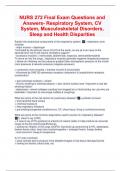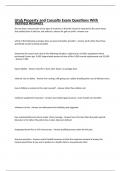Exam (elaborations)
NURS 272 Final Exam Questions and Answers- Respiratory System, CV System, Musculoskeletal Disorders, Sleep and Health Disparities
- Course
- Institution
Explain the anatomical components of the respiratory system. > respiratory zone muscles - major muscle = diaphragm *controlled by the phrenic nerve (C3-C5 of the neck), so any pt w an injury to the spine/phrenic nerve will require ventilatory support! - accessory muscles = intercostals, abdomina...
[Show more]




